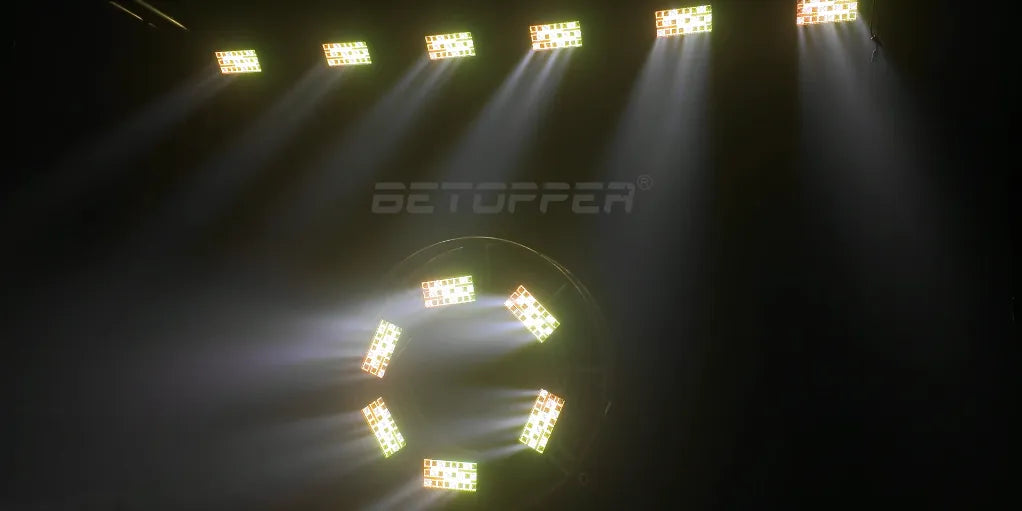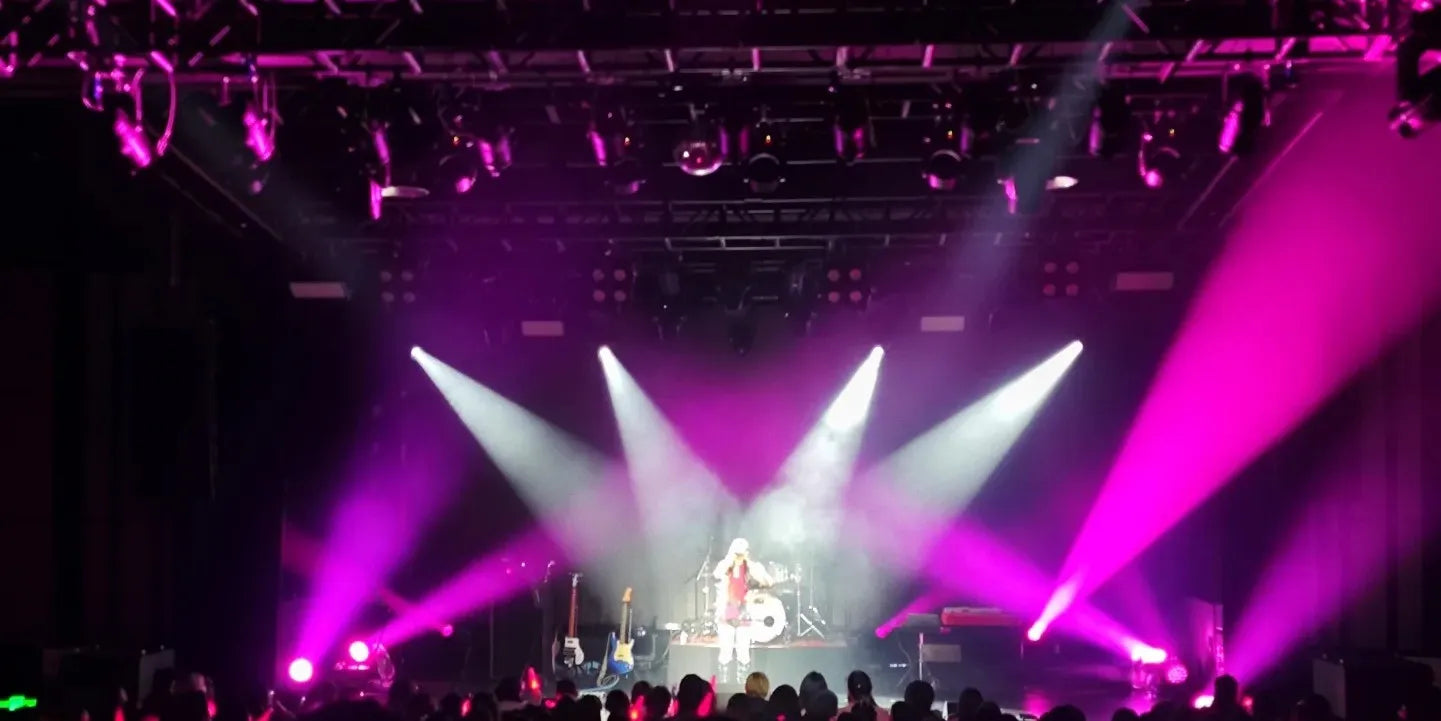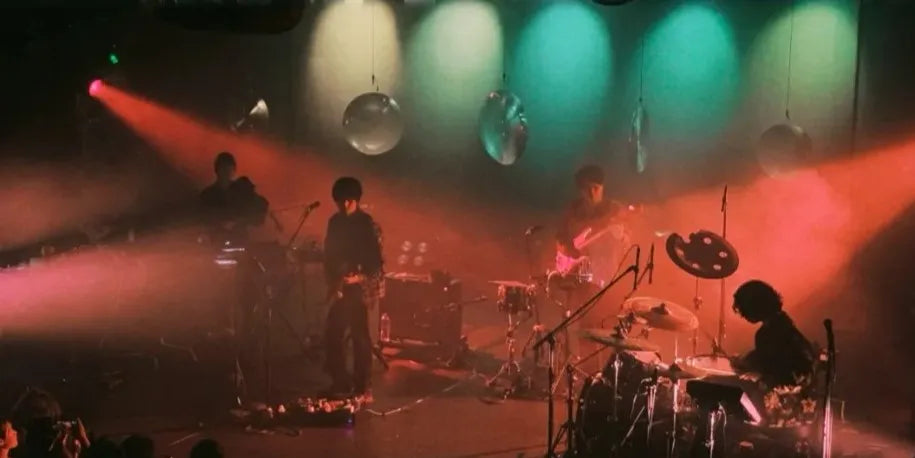Introduction
Stage lighting isn’t just about turning lights on — it’s about shaping atmosphere, enhancing performances, and creating unforgettable visual moments. Whether you're a DJ, event planner, or stage designer, understanding key stage lighting terms can dramatically improve how you control and design your shows.
In this guide, we’ll break down two essential lighting concepts: CRI lighting (Color Rendering Index) and Strobe / Shutter effects.
✨ High CRI lighting ensures your colors, fabrics, and faces look vivid and natural, making it perfect for weddings, theaters, and live streaming.
⚡ Strobe lighting brings energy and intensity to DJ sets, concerts, and festivals.
By the end of this article, you’ll understand not only what these terms mean, but also how to use them effectively in your lighting setup — whether you're working with wash lights, pixel strobes, or hybrid moving heads.

CRI — Color Rendering Index
What it means:
CRI (Color Rendering Index) measures how accurately a light source reveals colors compared to natural sunlight. The scale runs from 0 to 100. A higher CRI means colors appear more vivid, natural, and true to life under the lighting.
Why it matters:
- High color accuracy — Essential for theatrical productions, weddings, photography, and product displays.
- Better skin tone rendering — Especially important for stages, fashion shows, or live streaming.
- Professional lighting quality — High CRI ensures consistent, natural lighting output.
How it works:
- Lighting with CRI 95+ shows fabric colors, skin tones, and scenic elements with minimal color shift, creating a realistic and immersive environment.
- For example, a high-CRI wash light such as the LPC010-B High CRI PAR Light
will make costumes look rich and accurate, unlike low-CRI lights that can make them look dull or washed out.
Things to keep in mind:
- High CRI fixtures may have slightly lower lumen output than low-CRI ones.
- CRI is most critical in white light modes or neutral tones.
- Always check CRI specs when lighting faces or surfaces that will be photographed or filmed.
Shutter / Strobe — Dynamic Flashing Effects
What it means:
The Shutter is a built-in electronic function that controls how quickly the light turns on and off.
When this happens at a very fast speed, it creates a Strobe effect — a rapid flashing of light that matches the music or stage rhythm.
- Think of it as the heartbeat of a light:
- A slow shutter creates soft blinking.
- A fast shutter creates an intense strobe that boosts energy on stage.
Why it matters:
- Boosts energy instantly — strobe lighting makes music and stage effects feel more powerful.
- Perfect for high-energy environments like concerts, clubs, and DJ sets.
- Syncs with the beat, making the light feel like part of the music.
How it works:
- The fixture switches the light output on and off many times per second.
A slow shutter gives gentle pulses, while a fast shutter creates a hard, rapid strobe that can match drum beats or drops. - For example, when the bass drops in a song, activating strobe mode creates a blinding flash effect that moves with the beat, instantly lifting the atmosphere.
A powerful option for this effect is the LF350 Matrix Strobe Effect Moving Head Light, which delivers strong output, fast shutter response, and pixel control for dynamic visual impact.
Things to keep in mind:
- Use strobe carefully — flashing too fast or too often may cause discomfort for some people.
- Strobe speed is measured in Hertz (Hz): higher Hz = faster flashes.
- Many fixtures allow you to adjust the shutter speed or create custom strobe patterns.
- When used properly, strobe lighting can dramatically intensify the energy of a live event without overwhelming the audience.
FAQ— About CRI & Strobe Lighting
Q1: What is CRI in stage lighting and why is it important?
CRI (Color Rendering Index) measures how accurately a light source reproduces colors compared to natural sunlight. A high CRI (90+) ensures realistic colors, natural skin tones, and professional lighting quality — ideal for weddings, theatrical productions, and live streaming.
Q2: How to choose the best high CRI stage light for my event?
Look for fixtures with CRI 90+ or higher. These lights make fabrics and faces look vibrant on stage and on camera. A great example is the LPC010-B High CRI PAR Light
, which delivers exceptional color rendering for both indoor and outdoor events.
Q3: What is the difference between Shutter and Strobe effects?
The Shutter controls how quickly the light turns on and off. When it flashes rapidly, it becomes a Strobe — creating fast, rhythmic bursts of light. This effect is commonly used in DJ lighting, clubs, and live concerts to amplify the energy of a performance.
Q4: How to use strobe lighting safely at events?
Strobe lighting can be powerful, but overuse may cause discomfort for some audiences. Always adjust the frequency (measured in Hz) and avoid prolonged flashing. A reliable option for dynamic strobe effects is the LF350 Matrix Strobe Effect Moving Head Light
, designed for DJs and stage productions.
Q5: Can I mix high CRI lighting and strobe effects in one setup?
Yes — many modern lighting setups combine high CRI wash lights for ambient lighting and strobe fixtures for high-energy effects. This creates a balanced visual experience that’s both clean on camera and exciting for the crowd.
Elevate Your Stage Lighting with CRI and Strobe Effects
Mastering CRI lighting and strobe effects isn’t just about understanding technical terms — it’s about creating unforgettable moments. Whether you’re lighting up a wedding, DJ set, or live stage, these two fundamentals can take your visual impact to the next level.
👉 Explore more professional stage lighting solutions at betopperdj.com and build a setup that truly stands out.




Laisser un commentaire
Tous les commentaires sont modérés avant d'être publiés.
Ce site est protégé par hCaptcha, et la Politique de confidentialité et les Conditions de service de hCaptcha s’appliquent.